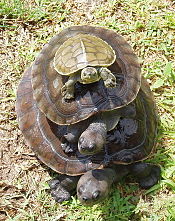Khorat snail-eating turtle
Appearance
| Khorat snail-eating turtle | |
|---|---|

| |
| Scientific classification | |
| Domain: | Eukaryota |
| Kingdom: | Animalia |
| Phylum: | Chordata |
| Class: | Reptilia |
| Order: | Testudines |
| Suborder: | Cryptodira |
| Superfamily: | Testudinoidea |
| Family: | Geoemydidae |
| Genus: | Malayemys |
| Species: | M. khoratensis
|
| Binomial name | |
| Malayemys khoratensis | |
| Synonyms[3] | |
| |
The Khorat snail-eating turtle (Malayemys khoratensis) is a species of turtle in the family Geoemydidae. They are freshwater turtles from Khorat Plateau in Thailand (hence where they get their name from) but were found for the first time in Udon Thani, Thailand.[4][5]
References
Wikispecies has information related to Malayemys khoratensis.
- ^ "Appendices | CITES". cites.org. Retrieved 2023-03-01.
- ^ Ihlow, F., Vamberger, M., Flecks, M., Hartmann, T., Cota, M., Makchai, S., Meewattana, P., Dawson, J. E., Long Kheng, L., Rödder, D. & Fritz, U. 2016. Integrative Taxonomy of Southeast Asian Snail-Eating Turtles (Geoemydidae: Malayemys) Reveals a New Species and Mitochondrial Introgression. PLoS ONE 11(4):e0153108. doi:10.1371/journal.pone.0153108.
- ^ Thomson, S. A., Lambertz, M. 2017. On the Nomenclatural Status of the Recently Described Snail-eating Turtle from Southeast Asia (Testudines, Geoemydidae): Malayemys khoratensis Ihlow et al. 2016 vs. Malayemys isan Sumontha et al. 2016. Chelonian Conservation and Biology. December 2017, 16(2):239-245 [1]PDF
- ^ Chiangkul, Krittiya; Trivalairat, Poramad; Purivirojkul, Watchariya (2018). "Redescription of the Siamese shield leechPlacobdelloides siamensiswith new host species and geographic range". Parasite. 25: 56. doi:10.1051/parasite/2018056. ISSN 1776-1042. PMC 6254108.
- ^ Platt, Steven G.; Thongsavath, Oudomxay; Leslie, Samuel C.; Brakels, Peter; Dawson, Jeffery E.; Ihlow, Flora; Rainwater, Thomas R. (2022-06-13). "On the Occurrence of the Khorat Snail-Eating Turtle (Malayemys khoratensis) in Lao People's Democratic Republic with Notes on Traditional Ecological Knowledge and Exploitation". Chelonian Conservation and Biology. 21 (1). doi:10.2744/ccb-1525.1. ISSN 1071-8443.

